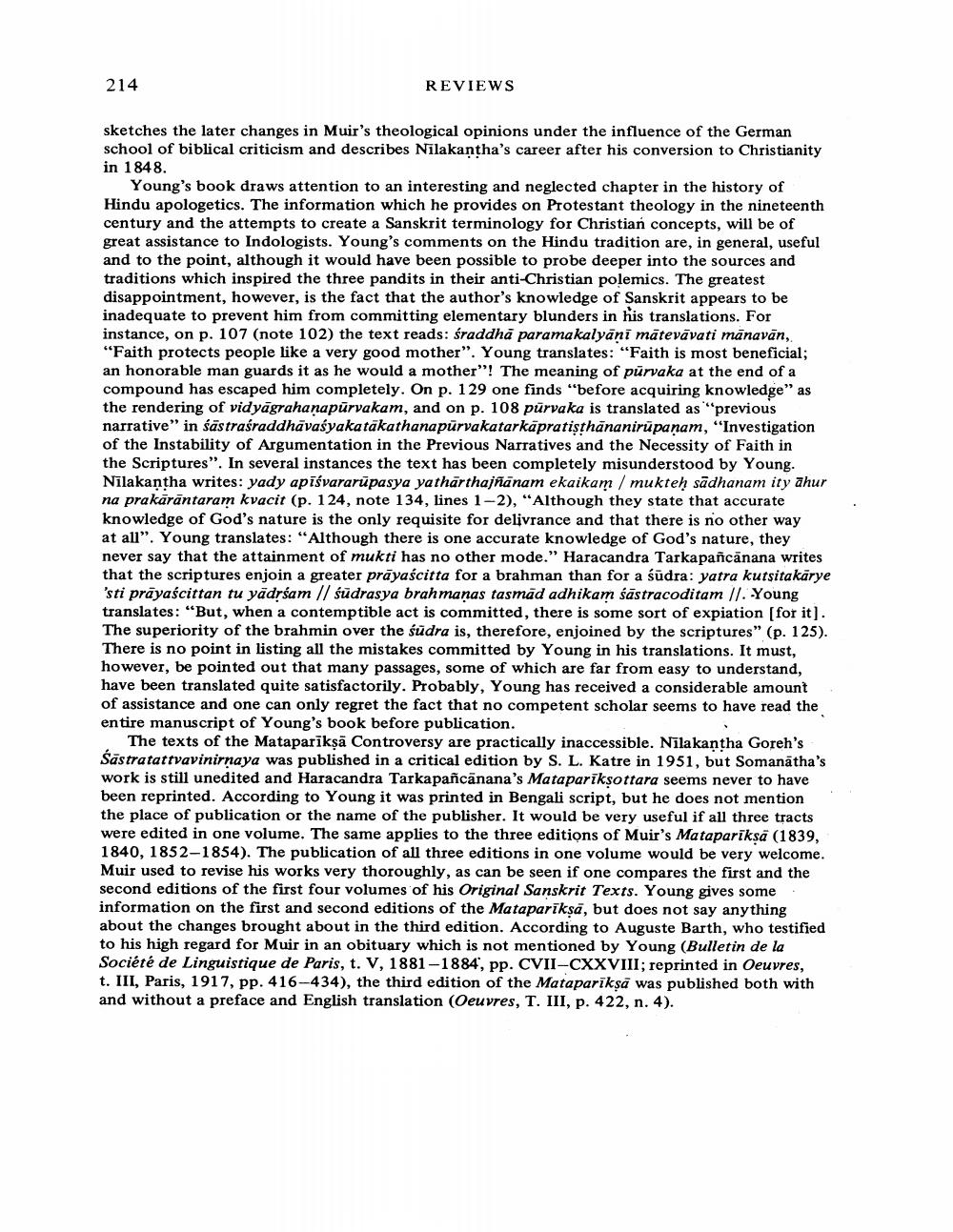Book Title: Book Reviews Author(s): J W De Jong Publisher: J W De Jong View full book textPage 4
________________ 214 REVIEWS sketches the later changes in Muir's theological opinions under the influence of the German school of biblical criticism and describes Nilakantha's career after his conversion to Christianity in 1848. Young's book draws attention to an interesting and neglected chapter in the history of Hindu apologetics. The information which he provides on Protestant theology in the nineteenth century and the attempts to create a Sanskrit terminology for Christian concepts, will be of great assistance to Indologists. Young's comments on the Hindu tradition are, in general, useful and to the point, although it would have been possible to probe deeper into the sources and traditions which inspired the three pandits in their anti-Christian polemics. The greatest disappointment, however, is the fact that the author's knowledge of Sanskrit appears to be inadequate to prevent him from committing elementary blunders in his translations. For instance, on p. 107 (note 102) the text reads: śraddhā paramakalyāni mātevāvati mānavān, "Faith protects people like a very good mother". Young translates: "Faith is most beneficial; an honorable man guards it as he would a mother”! The meaning of purvaka at the end of a compound has escaped him completely. On p. 129 one finds "before acquiring knowledge" as the rendering of vid yāgrahanapūrvakam, and on p. 108 pūrvaka is translated as previous narrative" in śästraśraddhāvaśyakatākathanapūrvakatarkāpratisthānanirüpanam, "Investigation of the Instability of Argumentation in the Previous Narratives and the Necessity of Faith in the Scriptures". In several instances the text has been completely misunderstood by Young. Nīlakantha writes: yady apiśvararūpasya yatharthajñanam ekaikam / mukten sādhanam ity āhur na prakārāntaram kvacit (p. 124, note 134, lines 1-2), “Although they state that accurate knowledge of God's nature is the only requisite for delivrance and that there is no other way at all". Young translates: "Although there is one accurate knowledge of God's nature, they never say that the attainment of mukti has no other mode." Haracandra Tarkapancānana writes that the scriptures enjoin a greater prāyaścitta for a brahman than for a śūdra: yatra kutsitakārye 'sti prāyaścittan tu yādrśam // sūdrasya brahmanas tasmad adhikam śāstracoditam //. Young translates: “But, when a contemptible act is committed, there is some sort of expiation (for it). The superiority of the brahmin over the südra is, therefore, enjoined by the scriptures" (p. 125). There is no point in listing all the mistakes committed by Young in his translations. It must, however, be pointed out that many passages, some of which are far from easy to understand, have been translated quite satisfactorily. Probably, Young has received a considerable amount of assistance and one can only regret the fact that no competent scholar seems to have read the entire manuscript of Young's book before publication. The texts of the Mataparīksā Controversy are practically inaccessible. Nīlakantha Goreh's Šāstratattvavinirnaya was published in a critical edition by S. L. Katre in 1951, but Somanātha's work is still unedited and Haracandra Tarkapañcanana's Matapariksottara seems never to have been reprinted. According to Young it was printed in Bengali script, but he does not mention the place of publication or the name of the publisher. It would be very useful if all three tracts were edited in one volume. The same applies to the three editions of Muir's Matapariksā (1839, 1840, 1852-1854). The publication of all three editions in one volume would be very welcome. Muir used to revise his works very thoroughly, as can be seen if one compares the first and the second editions of the first four volumes of his Original Sanskrit Texts. Young gives some. information on the first and second editions of the Mataparīksā, but does not say anything about the changes brought about in the third edition. According to Auguste Barth, who testified to his high regard for Muir in an obituary which is not mentioned by Young (Bulletin de la Société de Linguistique de Paris, t. V, 1881-1884, pp. CVII-CXXVIII; reprinted in Oeuvres, t. III, Paris, 1917, pp. 416-434), the third edition of the Matapariksā was published both with and without a preface and English translation (Oeuvres, T. III, p. 422, n. 4).Page Navigation
1 2 3 4 5 6 7 8 9 10 11 12 13 14 15 16 17 18 19 20 21 22
